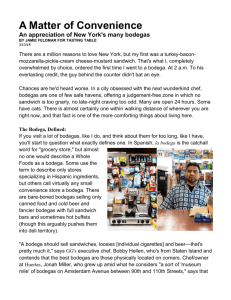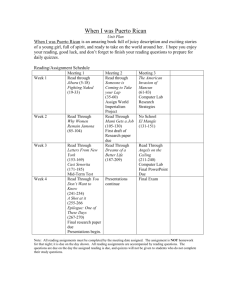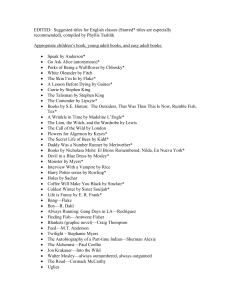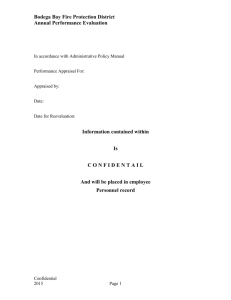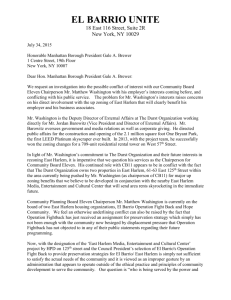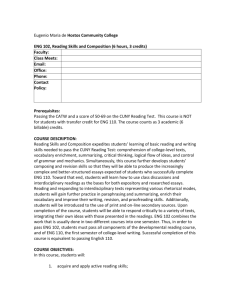Inter-University Program for Latino Research
advertisement
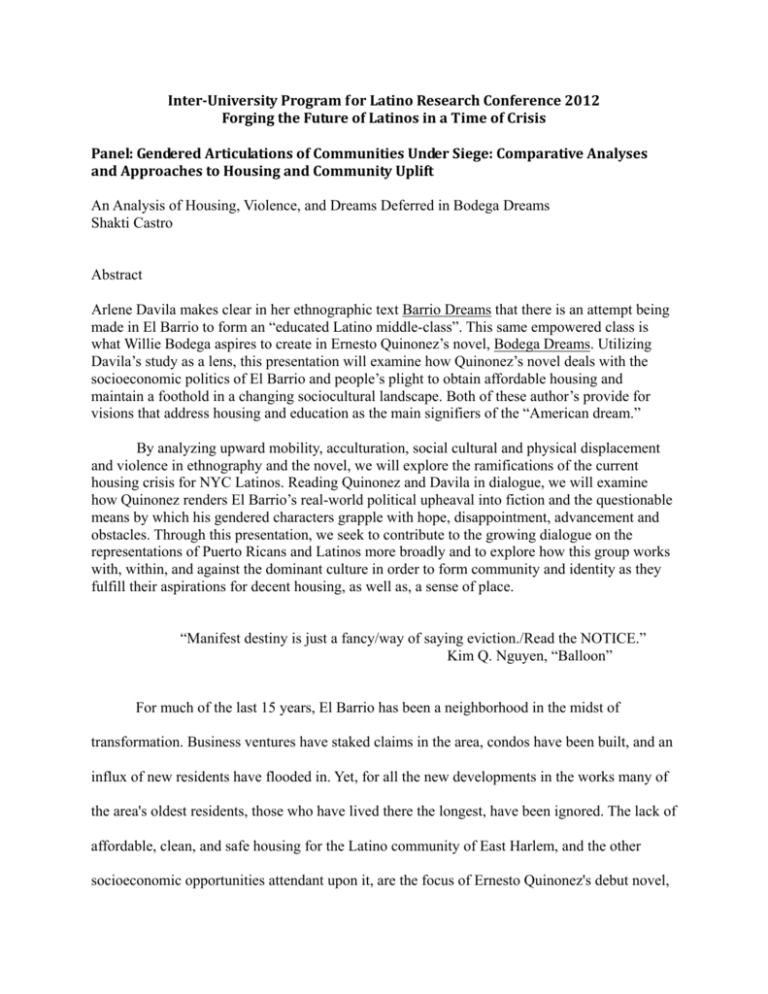
Inter-University Program for Latino Research Conference 2012 Forging the Future of Latinos in a Time of Crisis Panel: Gendered Articulations of Communities Under Siege: Comparative Analyses and Approaches to Housing and Community Uplift An Analysis of Housing, Violence, and Dreams Deferred in Bodega Dreams Shakti Castro Abstract Arlene Davila makes clear in her ethnographic text Barrio Dreams that there is an attempt being made in El Barrio to form an “educated Latino middle-class”. This same empowered class is what Willie Bodega aspires to create in Ernesto Quinonez’s novel, Bodega Dreams. Utilizing Davila’s study as a lens, this presentation will examine how Quinonez’s novel deals with the socioeconomic politics of El Barrio and people’s plight to obtain affordable housing and maintain a foothold in a changing sociocultural landscape. Both of these author’s provide for visions that address housing and education as the main signifiers of the “American dream.” By analyzing upward mobility, acculturation, social cultural and physical displacement and violence in ethnography and the novel, we will explore the ramifications of the current housing crisis for NYC Latinos. Reading Quinonez and Davila in dialogue, we will examine how Quinonez renders El Barrio’s real-world political upheaval into fiction and the questionable means by which his gendered characters grapple with hope, disappointment, advancement and obstacles. Through this presentation, we seek to contribute to the growing dialogue on the representations of Puerto Ricans and Latinos more broadly and to explore how this group works with, within, and against the dominant culture in order to form community and identity as they fulfill their aspirations for decent housing, as well as, a sense of place. “Manifest destiny is just a fancy/way of saying eviction./Read the NOTICE.” Kim Q. Nguyen, “Balloon” For much of the last 15 years, El Barrio has been a neighborhood in the midst of transformation. Business ventures have staked claims in the area, condos have been built, and an influx of new residents have flooded in. Yet, for all the new developments in the works many of the area's oldest residents, those who have lived there the longest, have been ignored. The lack of affordable, clean, and safe housing for the Latino community of East Harlem, and the other socioeconomic opportunities attendant upon it, are the focus of Ernesto Quinonez's debut novel, Bodega Dreams and Arlene Davila's ethnographic study and text, Barrio Dreams. The political climate that gave rise to both books has not changed much since their publication. Indeed, the dearth of housing has only worsened with the current economic crisis and Pew numbers show that Latinos, as a whole, have been disproportionately affected by the recent economic downturn. In contrast to this, rents in East Harlem have shot up significantly and the ability to obtain public and private funding for community uplift programs has been drastically curtailed. With these facts in mind, we turn to the issues of housing, violence, and upward mobility in Quinonez's novel using Davila's text as a lens. Willie Bodega, the character at the heart of Bodega Dreams, is a man on a mission. An ex-Young Lord turned drug dealer and entrepreneur, he focuses his time, attention, and money on building an empowered Latino middle-class. His goal lies in wresting El Barrio away from outside interests, in building a community of moneyed, educated young Latinos who will be able to “steal with the right papers”. As Davila points out in Barrio Dreams, “Housing and empowerment have long been inexorably connected in East Harlem and in government policies that appealed to people's housing aspirations and longing for place” (Davila 30). Bodega makes this point somewhat less eloquently on his first meeting with Chino, the novel's young narrator. Selling Chino on his two-fold Grand Plan, to finance the education of the young Latinos of El Barrio in order to create a class of lawyers, doctors, and businessmen and, at the same time, to buy up property in East Harlem to fill with those students, their families and other hardworking Latinos in need of homes, he elucidates Davila's point: “...I'm talking about property. I'm talking about owning the neighborhood legally. The way the Kennedys own Boston. Now this ain't fucken Boston. This's New York City. Manhattan. Location is everything. I'm talkin' about ownin' a big chunk of the most expensive real estate in all the nine planets.” (Quinonez 37)” Bodega is keenly aware that the only way for Latinos to make it is to map themselves and their advancement onto strategies first 'pioneered' by the very dominant culture that now holds them in contempt. When Chino sneeringly asks him why he's so obsessed with the Kennedys, Bodega simply answers “B'cause you gotta have a blueprint” (Quinonez 37) Chino, as a student at Hunter College, numbers among those Bodega hopes will lead the next generation. Chino, for his part, is less interested in being one of Bodega's “army of professionals” than in moving his pregnant wife, Blanca, into a better home. As Chino, and the real-world residents of El Barrio, know all too well “Upward mobility [is] synonymous with leaving El Barrio for Puerto Rico, Connecticut, New Jersey, The Bronx, or just about any suburb. “ (Davila 38) Bodega's interest in Chino, on the other hand, lies somewhat closer to the heart. Blanca is the niece of Veronica “Vera” Saldivia, Willie Bodega's long-lost love, now married to a wealthy Cuban. It is Bodega's hope that Chino's familial ties to Vera will help him to both track her down and make contact with her. Chino himself tells us that for Latinos, there's nothing like family, no matter how distant a relation. In this case, Vera has escaped El Barrio moving onward and upward by marrying a rich, older Cubano. Though Quinonez refrains from pointing out the obvious, Vera's loveless marriage is a painful reminder of how limited options for advancement in working-class communities can be, especially for women. The implication is clear in the novel, a woman must use whatever means are at her disposal. Even unto the point of leaving home and changing her name in order to advance her life and social standing. At the heart of this idea, of staking claim, is the importance of El Barrio to the cultural imagination of Puerto Ricans. The site of the first colonia in New York City, East Harlem is where many newly arrived Puerto Rican migrants chose to make their homes. Abandoned by the mayor's office during the urban blight of the 1960s and 1970s, it has emerged as a new, trendy area for young white professionals to live in the new millennium. Fighting back against this tide of gentrification involves establishing a firmer foothold, both in commercial and residential space, and in local politics. El Barrio's transformation in the light of new corporate (and culturally misappropriating) interests extends to its very name. Even its moniker is under attack from those hoping to 'sell' the area. Quinonez makes obvious the importance and danger of branding and rebranding an area like Spanish Harlem, with its history of neglect and targeted discrimination, reminding us that names are powerful markers of identity and serve to tie people and places inextricably together. This is highlighted early within his novel when Chino, his wife Blanca, and their friend Sapo question a white teacher on why they've never read a poem by Julia de Burgos, a Puerto Rican poet and the namesake of their middle school, only to be confronted with the painful reality that both Julia de Burgos and they, as Puerto Rican students, are largely irrelevant in the eyes of many of their white teachers. (Quinonez 89) Paralleling this idea of naming tied to place, Davila documents the corporate 'whitewashing' of El Barrio, focusing on what names mean and what they're used for as she writes of the 'rebranding' of El Barrio to appeal to corporate interests and young white professionals: “For these varied interests, El Barrio is East Harlem, Upper Yorkville, or Spaha (for Spanish Harlem, echoing the trendy abbreviated names for neighborhoods like SoHo) and a very different community from that anticipated by the Puerto Rican leadership.” (Davila 58) Of course, the Puerto Rican leadership envisions the area as primarily Puerto Rican, though over the years, the area has become home to many other Latino immigrants as well, challenging the typical notion that El Barrio is a Puerto Rican space. For Puerto Ricans and other Latino groups, however, El Barrio is “at least Latino” and the importance lies in keeping it as such. As Davila notes, a prevailing saying in East Harlem is “El Barrio es de Todos”, so important is this statement that she chooses to name a chapter of her text after it, and to explore the dynamics of Latinidad in the neighborhood and what it means for ideas of ownership. Quinonez touches upon Latinidad in Bodega Dreams as well, underscoring both its potential for community formation and its ability to come between various Latino/a groups. This is primarily evident when Bodega's right-hand man and lawyer, Nazario, emphatically exclaims to the residents of one of Bodega's buildings, now the victims of arson, that they will pull through "We are Puerto ricans! We are Latinos!", thus reinscribing Davila's observation of East Harlem as specifically a Puerto Rican space, and more generally a Latino one. This also arises earlier in the novel with Chino's somewhat sheepish admission to Bodega that he is actually half-Ecuadorian. Bodega, for his part, is unfazed, reminding him that he's “Spanish” and “from the area”, codifying in the novel acceptable markers for inclusion in both the neighborhood as a physical space and the cultural imaginary of the Puerto Ricans who live there. Yet, for all the inclusion evident in Bodega's words, the complexities of Latinidad comprise difference, distance, and discrimination as well. Vera, Bodega's love interest and a character upon whom much of the story pivots, is married to a wealthy Cuban man who functions as a counterpoint to the ideal of Latinidad as community when he insultingly tells Bodega that he 'knows his kind', going on to tell him: “You're one of those nickel-and-dime drug people. It figures, that's all you people in this neighborhood can do. You couldn't make an honest buck if the work was given to you.” (Quinonez 191) Latinidad in El Barrio is probably based almost as much on economic factors as on cultural ones. The economic opportunities afforded by reliable and stable housing are stressed by Quinonez and Davila, as housing is just one aspect of a long, complicated struggle for advancement and the realization of the American dream. However, many other factors are involved in claiming space and identity. Chief among both Bodega's and Chino's concerns is education. Chino himself mentions that what little financial aid is available is nearly impossible to come by for 'people like him' and his wife Blanca. Both work hard, go to school, and avoid the more nefarious activities that abound in Spanish Harlem. So what, then, is someone like him? A young, working-class person of color. His statement, coupled with Bodega's dependence on education as a means of reform in the area, reenforce the idea that everything in El Barrio is linked. The need to maintain safe, affordable housing has an effect on the ability to procure the education that would eventually help one to leave El Barrio and “move on up”. Of course, for all Bodega's big dreams they are deeply tied to violence and illegality and dependent upon a level of harm inflicted on the very neighborhood he is attempting to lift up. Even Chino, on their first meeting, points this out telling him the only problem in his grand plan is that he's “selling that stuff to his own people”. Selling heroin to your own neighbors and engaging in violent turf war with other drug dealers hardly seems heroic. Perhaps it is Bodega's deeply flawed vision that is so relevant for Quinonez to show. Bodega's abandoning of his Young Lords idealism, and his adoption (and adaptation) of cutthroat, capitalist practices serve as an eery mirror onto the most problematic aspects of the dominant culture's treatment of El Barrio and other working-class, minority areas. It is this violence that eventually paves the way for the cover-up of Bodega's murder at the hands of his best friend, Nazario, and the woman they both loved, Vera. Though Quinonez and Davila veer away from focusing too heavily on gender politics within the area, it's worth noting how deeply these identities are rooted into both El Barrio and Puerto Rican culture as a whole as this figures prominently into discourses surrounding both belonging to place and the history of the Puerto Rican migration. At the heart of Bodega's demise lies both a complex relationship with his right hand man and lawyer, Nazario, and his love affair with Vera, Blanca's aunt. Nazario and Bodega can be said to embody two competing visions of Latin maleness. Bodega may be the visionary in this grand scheme, but Nazario is the educated lawyer, the one with contacts in city hall. Bodega serves as the money-man, a sweet tongued gangster, Nazario as a stoic diplomat on his behalf. This gendering is not limited to the male characters of the novel. Blanca, her sister Negra, and Chino as well are deeply gendered characters. At one point, Chino jokingly alludes to his own “uneasy” masculinity, telling the reader that it is Blanca who holds the power in their home. To illustrate the facetious elements of the stereotype of the abused and timid Latin woman, he says “If you dare hit a Latin woman God help you, because you'll wake up with scissors in your back.” (Quinonez 38) Blanca and her sister Negra are gendered in relation to each other, existing on a continuum of literal lightdarkness. This is dependent upon not only their physical appearances, but their night and day personalities as well. Blanca, the religious, married, “good” sister is nicknamed Blanca not only because of her light skin, but because she embodies purity and modern marianismo. Negra, on the other hand, is “loud”, “nosy”, and violent. She even becomes embroiled in a physical altercation with her husband that ends with her stabbing him. In these ways Negra embodies the opposite stereotype, the myth of the Latin woman as hot-blooded, violent, and prone to performing masculinity. The mere existence of Quinonez's novel is a political act in and of itself. It's a story not merely set in El Barrio, but one deeply invested in, and concerned with, the cultural and socioeconomic politics of the area as space and place. Though he ultimately fails, Bodega's story is not meant to be a warning, a precautionary tale to those who would dare dream of reinventing East Harlem, of breaking all the rules, of reimagining the game on different terms. Rather, Bodega's willingness to live and dies for his dream of empowered Puerto Ricans and Latinos, of people who don't merely occupy space at the discretion of God, or any other wouldbe landlords, reminds us of the oftentimes treacherous road to advancement. Quinonez, for the most part, avoids demonizing Willie and his most problematic ways of realizing his dream, instead choosing to focus his lens on the difference between those aspects of the dominant culture that we, as Latinos, should map onto in order to advance ourselves, (i.e. education and a stake in political dealings) while reminding us that capitalism can be a zero-sum game for those of us with a history of being at its mercy.

